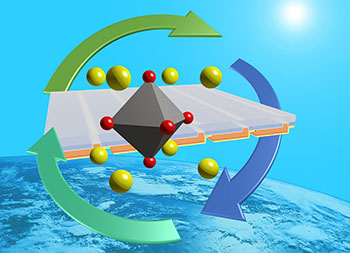
Semi-cubic structure of perovskite materials, and how they would fit into a solar power device. Credit: Seth Darling / Northwestern University
Perovskite photovoltaics (PVs) have received a lot of attention for their potential to offer higher-power conversion efficiencies at lower manufacturing costs than mature PV technologies. But how do their environmental costs compare to those of existing solar panels? U.S. researchers from Northwestern University and Argonne National Laboratory performed a life-cycle assessment (LCA) on two types of perovskite solar modules and compared them to commercial technologies to determine their total energy and environmental impact (Energy & Env. Sci., doi: 10.1039/c5ee00615e). LCA data showed the perovskite PVs, as they currently exist, had the shortest energy payback time (EPBT), but a relatively large carbon footprint compared with other solar panels.
Solar cells could help keep up with the growing global demand for energy by providing renewable, large-scale power that’s cleaner than fossil fuels. To evaluate solar cell performance, the Northwestern and Argonne team developed a systematic approach that considers conversion efficiency—the most common performance metric—as well as energy payback time, which measures energy inputs and outputs from the mining of raw materials to disposal.
Using a comprehensive LCA, the group collected data for 16 common impact indicators, as well as EPBT and CO2 emission factors (defined as total carbon footprint divided by the energy produced during the product’s life cycle), for two perovskite solar modules and existing solar cell technologies. They also ran uncertainty and sensitivity analyses to identify the two most influential parameters driving overall cost of perovskite PVs.
Compared with existing technologies, the two perovskite PV modules had the shortest EPBTs. Estimated in real time, commercially available silicon-based panels need between one and four years to recover invested energy, compared to perovskite PVs, which could potentially return the investment in two or three months. The researchers also found that the perovskite PVs had larger CO2 emission factors, mainly due to their relatively short lifetime (2 years for perovskite modules, versus 20 years for silicon-based modules). The LCA identified other hot spots that increased environmental costs for perovskite PVs, including the use of gold, ITO glass, organic solvents and thermal evaporation during manufacturing. The uncertainty and sensitivity analyses identified performance ratio and lifetime as the most influential parameters driving perovskite solar module performance and cost.
The authors say that while the technology remains promising, their assessment shows that engineers need to extend module lifetime, improve the system performance ratio, and reduce environmental impact before perovskite PVs go to market.
